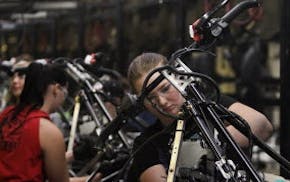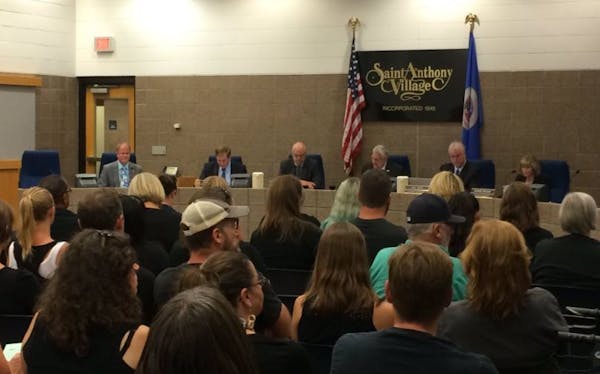After a long day of conflict between demonstrators and police at the governor's Summit Avenue residence in St. Paul, dozens of protesters were arrested.
In separate actions during the day, 15 protesters were cited and released and another 10 were arrested and booked into Ramsey County jail for processing, said St. Paul Police Chief Todd Axtell. A Metro Transit bus left the scene at 7:30 p.m. with about 20 more arrestees on board.
Those arrested will face charges ranging from disorderly conduct to unlawful assembly to public nuisance, St. Paul police said.
Summit Avenue seesawed between being open and closed to car traffic. By 6 p.m., the demonstrators' encampment was largely cleared away. Police tweeted just before 7 p.m. that protesters had been cleared from the location, but that the street would remain closed to vehicles, bikes and pedestrians.
By 11 p.m., the scene had shifted away from the residence, and a line of more than three dozen police officers faced down a sometimes-vocal crowd of about 150 protesters about a block away, at the corner of Summit Avenue and Oxford Street.
Around 2:30 a.m. Wednesday an additional 23 people were arrested at that intersection for public nuisance and unlawful assembly, bringing the total arrests to about 70, police said.
"We continue to be committed to allow for peaceful protests, but we have an obligation that people are safe and follow the rules, and when that's no longer the case we need to take action, like we did today," St. Paul Mayor Chris Coleman said at an afternoon news conference.
In varying numbers, protesters have occupied the parkway and sometimes the street there since the fatal police shooting of Philando Castile in Falcon Heights three weeks ago.
Officers began their action about 7:15 a.m., when protesters were found "sleeping in the street on blankets," said St. Paul police spokesman Steve Linders.
Protesters for the most part complied, and packed up their belongings, Linders said, adding that the activists had with them tents, tarps, tables, open umbrellas and other items that were obstructing the street and sidewalk. The protesters also had built fires, police said.
"Ladies and gentlemen, please remain peaceful and remain on the sidewalk; stay out of the road or you'll be arrested," a police officer said over a megaphone as a line of officers stood in the street.
Linders said the activists were welcome to protest on the sidewalk, but "they just can't have things that obstruct the sidewalk, the bike lane and the street."
Protester Jacob Ladda said police are "trying to strip us of our well-being. … They're asking us to remove water and food from the space — tents and other things that provide shade. They're using intimidation tactics rather than legal tactics."
Officers acted "politely" and "peacefully" Tuesday morning, Coleman said, but there were some "folks who became defiant and some became dangerous."
Ladda said the protesters' plan is to "stay as long as we have to stay here for that police officer to be held [accountable] in a court of law for homicide."
Henry Habu, who was sweeping the sidewalk about 10 a.m. as 25 or so protesters lingered, said, "This is a peaceful protest, and that's what we're here for. Every time we turn around, there's one of us getting killed. Same old thing is going on. Nothing has changed."
Chief Axtell said he met personally with protesters about 1 a.m. Monday. "We have had great dialogue with many of them" over the course of the past few weeks," Axtell said. Police gave out fliers explaining what would and would not be allowed at the governor's residence, "so that everyone knew the rules and laws," he added.
As noon approached, a dozen police officers in riot gear encircled the encampment, calling it an "unlawful assembly" and saying everyone in front of the residence would be arrested.
In response to the officers' efforts, protesters shouted profanities at police while continuing "to block traffic and create a public nuisance," Linders said.
"Don't resist arrest!" one protester shouted. More than a dozen on the sidewalk were arrested about 12:20 p.m., some after struggling with arresting officers.
One bystander who lives nearby said a certain amount of disruption comes with the neighborhood. "When you want to live across the street from the governor's mansion, you have to accept it as part of the deal," said Renee Lorrain. "This is a far bigger deal than their inconvenience."
A celebratory rally on Sunday at the governor's residence to protest Castile's death had all the makings of a block party. The group then moved onto the street, which police last week had cleared of protesters without arrests and reopened to vehicle traffic.
Castile, 32, of St. Paul, was stopped July 6 in Falcon Heights by a St. Anthony police officer. Castile, who was black, was shot, and a video showing the immediate aftermath in the car was posted online by his girlfriend, who was sitting next to him.
The officer, who is Hispanic, said he stopped the car because Castile resembled a robber from a recent gas station holdup.
Video shot at the scene recorded the officer, Jeronimo Yanez, as saying that he had warned Castile "not to reach" for the gun he had with him. The girlfriend was heard on the video saying that Castile was not reaching for his gun and that he had a permit to carry the weapon.
Protests in other parts of the Twin Cities tied to Castile's death have led to the shutdowns of two interstate highways and many arrests.
Staff writers Karen Zamora and Pat Pheifer contributed to this report.
Paul Walsh • 612-673-4482

Minnesota added thousands of jobs in March but worker shortage still an issue
Private prison van driver, accused of raping St. Paul woman he was transporting, gets 30 years for similar attacks

Shop the curbs for free on 'Trash to Treasure Day' in White Bear Lake
Longtime Uptown boutique closing in May

